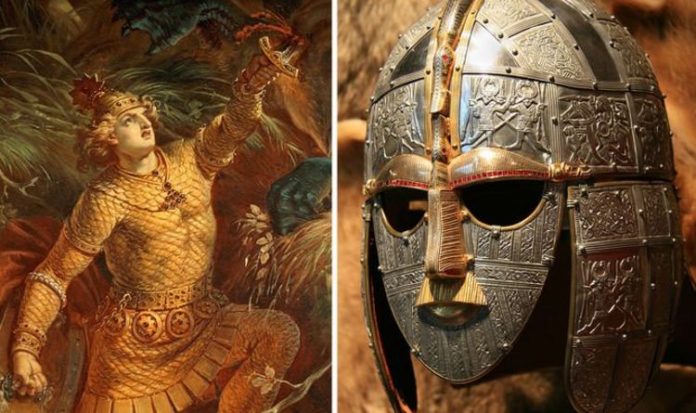The Dig: Carey Mulligan and Ralph Fiennes star in Netflix trailer
Netflix will release its new film ‘The Dig’ later this month depicting the events of the incredible excavation in Woodbridge, Suffolk. The area was at the centre of a huge discovery in 1939 when an Anglo-Saxon burial was uncovered. Archaeologists found two early medieval cemeteries that dated from the sixth to seventh centuries and they have continued to probe the area ever since.
Dr Sue Brunning is the is the curator of Early Medieval Europe Collections at the British Museum – where most of the artefacts are now held – and she detailed how the story unfolded.
She told Express.co.uk: “The estate of Sutton Hoo was owned by a lady called Edith Pretty, who features in the upcoming film.
“She was aware of a group of burial mounds on her property, which you can visit today.
“She had an interest in archaeology and was keen to investigate them further, so she employed archaeologist Basil Brown.

An illustration based on the Beowulf poem (Image: GETTY)

The discovery was made in 1939 (Image: GETTY)
“In 1938 he opened a couple of the smaller mounds and found they had been looted in the past and there was not much left except a few fragments of early Medieval objects.
“In 1939 he returned to Mrs Pretty’s estate and opened the largest burial mound – known as Mound 1 – that contained the ship burial.”
Dr Brunning detailed how things developed thereon, adding that the museum became involved with the excavations early on.
She explained: “The first thing that he discovered inside were a number of iron rivets, so he recognised he had a ship burial on his hands.
“He proceeded to follow their line and expose the imprint of the ship – the wood itself had rotted away, but it was left imprinted into the sand.
READ MORE: Archaeology breakthrough: 1,500-year-old ‘greatest treasure ever found on English soil’

Nextflix’s will release its new film later this month (Image: NETFLIX)
“At that point, it became clear that he had a really significant discovery on his hands.
“The British Museum and the Office of Works were consulted for advice and they appointed a professional archaeologist called Charles Phillips to supervise.”
And the expert in Early Medieval material culture revealed why the find was so significant.
She continued: “He put together the team who excavated the burial chamber discovered in the middle of the ship – it was inside there that the famous treasures were discovered.
“In the course of that discovery, they realised what they had was something completely unprecedented for this pored.
DONT MISS
End of the world: How archaeologist discovered ‘real Maayan doomsday’ [VIDEO]
Mayan DISCOVERY: How find in ancient city ‘reveals creation story’ [CLAIM]
Egypt: How ‘greatest archaeological find of all time’ stunned expert [REVEALED]

A hoard of Anglo-Saxon treasure was uncovered (Image: GETTY)
“It proved that the impression that we have of this medieval period told in poems like Beowulf – which described warriors wearing glittering war gear – thought to be just poetic – was actually a reality.
“This was a place of really sophisticated artistic culture with far-reaching international connections and quite complicated belief systems.
“It completely changed our understanding of this period.”
Beowulf is one of the most important and most translated works of Old English literature.
The story is set in pagan Scandinavia in the sixth century.
Beowulf, a hero of the Geats, comes to the aid of Hrothgar, the king of the Danes, whose mead hall in Heorot has been under attack by the monster Grendel.

The outline of the ship at Sutton Hoo (Image: GETTY)
After Beowulf slays him, Grendel’s mother attacks the hall and is then defeated.
Victorious, Beowulf goes home to Geatland (modern Sweden) and becomes king of the Geats.
Half a century later, Beowulf also defeats a dragon, but is mortally wounded in the battle.
After his death, his attendants cremate his body and erect a tower on a headland in his memory.
The ship burial has also prompted comparisons with the world described in the poem as it partly set in Gotaland in southern Sweden – which has archaeological parallels to some of the finds from Sutton Hoo.
Sutton Hoo: Expert speaks in 2009 about helmet discovery
The famous helmet retrieved from Sutton Hoo has been central to the theory, too.
With its panels of tinned bronze and assembled mounts, the decoration is directly comparable to that found on helmets from the Vendel and Valsgarde cemeteries of eastern Sweden.
But it differs from the Swedish examples in having an iron skull of a single vaulted shell and has a full face mask, a solid neck guard and deep cheekpieces.
These features have been used to suggest an English origin for the helmet’s basic structure – the deep cheekpieces have parallels in the Coppergate helmet, found in York.
Although outwardly very like the Swedish examples, the Sutton Hoo helmet is said to be a product of better craftsmanship.







